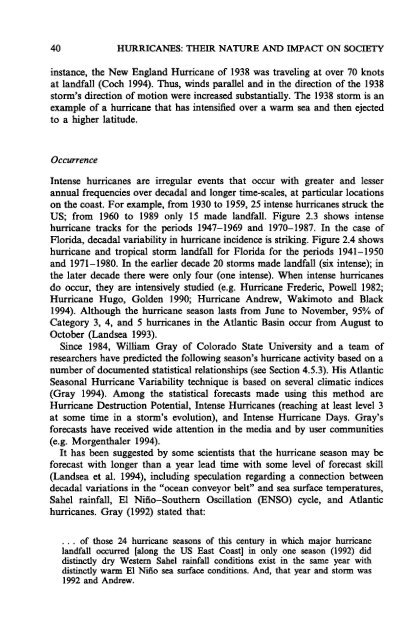Hurricanes: Their Nature and Impacts on Society - Climate Science ...
Hurricanes: Their Nature and Impacts on Society - Climate Science ...
Hurricanes: Their Nature and Impacts on Society - Climate Science ...
Create successful ePaper yourself
Turn your PDF publications into a flip-book with our unique Google optimized e-Paper software.
40<br />
HURRICANES: THEIR NATURE AND IMPACT ON SOCIETY<br />
instance, the New Engl<str<strong>on</strong>g>and</str<strong>on</strong>g> Hurricane of 1938 was traveling at over 70 knots<br />
at l<str<strong>on</strong>g>and</str<strong>on</strong>g>fall (Coch 1994). Thus, winds parallel <str<strong>on</strong>g>and</str<strong>on</strong>g> in the directi<strong>on</strong> of the 1938<br />
storm's directi<strong>on</strong> of moti<strong>on</strong> were increased substantially. The 1938 storm is an<br />
example of a hurricane that has intensified over a warm sea <str<strong>on</strong>g>and</str<strong>on</strong>g> then ejected<br />
to a higher latitude.<br />
Occurrence<br />
Intense hurricanes are irregular events that occur with greater <str<strong>on</strong>g>and</str<strong>on</strong>g> lesser<br />
annual frequencies over decadal <str<strong>on</strong>g>and</str<strong>on</strong>g> l<strong>on</strong>ger time-scales, at particular locati<strong>on</strong>s<br />
<strong>on</strong> the coast. For example, from 1930 to 1959,25 intense hurricanes struck the<br />
US; from 1960 to 1989 <strong>on</strong>ly 15 made l<str<strong>on</strong>g>and</str<strong>on</strong>g>fall. Figure 2.3 shows intense<br />
hurricane tracks for the periods 1947-1969 <str<strong>on</strong>g>and</str<strong>on</strong>g> 1970-1987. In the case of<br />
Florida, decadal variability in hurricane incidence is striking. Figure 2.4 shows<br />
hurricane <str<strong>on</strong>g>and</str<strong>on</strong>g> tropical storm l<str<strong>on</strong>g>and</str<strong>on</strong>g>fall for Florida for the periods 1941-1950<br />
<str<strong>on</strong>g>and</str<strong>on</strong>g> 1971-1980. In the earlier decade 20 storms made l<str<strong>on</strong>g>and</str<strong>on</strong>g>fall (six intense); in<br />
the later decade there were <strong>on</strong>ly four (<strong>on</strong>e intense). When intense hurricanes<br />
do occur, they are intensively studied (e.g. Hurricane Frederic, Powell 1982;<br />
Hurricane Hugo, Golden 1990; Hurricane Andrew, Wakimoto <str<strong>on</strong>g>and</str<strong>on</strong>g> Black<br />
1994). Although the hurricane seas<strong>on</strong> lasts from June to November, 95% of<br />
Category 3, 4, <str<strong>on</strong>g>and</str<strong>on</strong>g> 5 hurricanes in the Atlantic Basin occur from August to<br />
October (L<str<strong>on</strong>g>and</str<strong>on</strong>g>sea 1993).<br />
Since 1984, William Gray of Colorado State University <str<strong>on</strong>g>and</str<strong>on</strong>g> a team of<br />
researchers have predicted the following seas<strong>on</strong>'s hurricane activity based <strong>on</strong> a<br />
number of documented statistical relati<strong>on</strong>ships (see Secti<strong>on</strong> 4.5.3). His Atlantic<br />
Seas<strong>on</strong>al Hurricane Variability technique is based <strong>on</strong> several climatic indices<br />
(Gray 1994). Am<strong>on</strong>g the statistical forecasts made using this method are<br />
Hurricane Destructi<strong>on</strong> Potential, Intense <str<strong>on</strong>g>Hurricanes</str<strong>on</strong>g> (reaching at least level 3<br />
at some time in a storm's evoluti<strong>on</strong>), <str<strong>on</strong>g>and</str<strong>on</strong>g> Intense Hurricane Days. Gray's<br />
forecasts have received wide attenti<strong>on</strong> in the media <str<strong>on</strong>g>and</str<strong>on</strong>g> by user communities<br />
(e.g. Morgenthaler 1994).<br />
It has been suggested by some scientists that the hurricane seas<strong>on</strong> may be<br />
forecast with l<strong>on</strong>ger than a year lead time with some level of forecast skill<br />
(L<str<strong>on</strong>g>and</str<strong>on</strong>g>sea et al. 1994), including speculati<strong>on</strong> regarding a c<strong>on</strong>necti<strong>on</strong> between<br />
decadal variati<strong>on</strong>s in the "ocean c<strong>on</strong>veyor belt" <str<strong>on</strong>g>and</str<strong>on</strong>g> sea surface temperatures,<br />
Sahel rainfall, El Nino-Southern Oscillati<strong>on</strong> (ENSO) cycle, <str<strong>on</strong>g>and</str<strong>on</strong>g> Atlantic<br />
hurricanes. Gray (1992) stated that:<br />
...of those 24 hurricane seas<strong>on</strong>s of this century in which major hurricane<br />
l<str<strong>on</strong>g>and</str<strong>on</strong>g>fall occurred [al<strong>on</strong>g the US East Coast] in <strong>on</strong>ly <strong>on</strong>e seas<strong>on</strong> (1992) did<br />
distinctly dry Western Sahel rainfall c<strong>on</strong>diti<strong>on</strong>s exist in the same year with<br />
distinctly warm EI Nino sea surface c<strong>on</strong>diti<strong>on</strong>s. And, that year <str<strong>on</strong>g>and</str<strong>on</strong>g> storm was<br />
1992 <str<strong>on</strong>g>and</str<strong>on</strong>g> Andrew.














